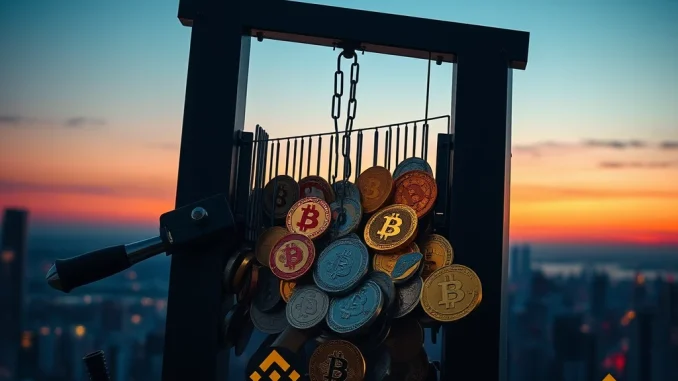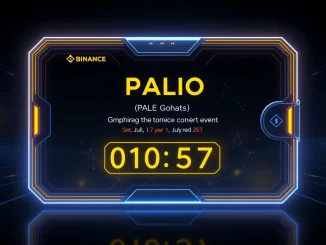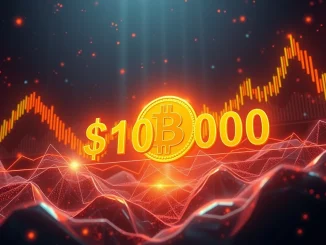
Heads up, crypto enthusiasts! Binance, one of the giants in the crypto exchange world, just dropped a bombshell. They’re set to delist a whopping 14 tokens on April 16th. Yes, you read that right – 14! This isn’t just a routine market adjustment; it’s a significant shake-up stemming from their ‘Vote to Delist’ program. Are your holdings affected? Let’s dive into the details of this major Binance delisting event and see what it means for you and the broader crypto market.
What’s the Buzz About This Crypto Delisting?
Binance, known for its extensive list of tradable cryptocurrencies, has announced the removal of several tokens. This move is based on their ‘Vote to Delist’ initiative, a program designed to ensure the quality and compliance of listed assets. The tokens facing delisting are:
- BADGER
- BAL
- BETA
- CREAM
- CTXC
- ELF
- FIRO
- HARD
- NULS
- PROS
- SNT
- TROY
- UFT
- VIDT
These tokens will no longer be available for trading on Binance starting April 16th. It’s crucial for anyone holding these assets to understand the implications and take necessary actions. But why exactly is Binance taking such a drastic step?
Digging Deeper: Why the Binance Token Delisting?
Binance regularly reviews each digital asset they list to ensure it continues to meet the high level of standard they expect. When a coin or token no longer meets these standards, or when market conditions and compliance requirements shift, Binance may decide to delist it. Here are some key reasons why a token delisting like this occurs:
- Low Trading Volume and Liquidity: If a token consistently shows low trading activity and lacks sufficient liquidity, it becomes less attractive for traders and the exchange. Delisting helps Binance maintain a vibrant and efficient trading environment.
- Technological or Smart Contract Issues: Problems with the underlying technology, network stability, or smart contracts of a token can raise red flags. Binance prioritizes the security and reliability of the assets on its platform.
- Lack of Development Activity: Active development and community support are vital for the long-term success of any cryptocurrency. If a project shows signs of stagnation or abandonment, it may be considered for delisting.
- Regulatory Compliance: The regulatory landscape for cryptocurrencies is constantly evolving. If a token faces regulatory scrutiny or compliance issues, Binance might preemptively delist it to stay ahead of potential problems.
- Ethical or Conduct Issues: Binance upholds certain ethical standards for projects listed on their exchange. If a project engages in unethical practices or misconduct, it could lead to delisting.
In this particular case, Binance explicitly mentioned that these delistings are a result of the ‘Vote to Delist’ program. This implies a community-driven aspect to the decision-making process, suggesting a broader consensus on these tokens no longer meeting Binance’s criteria.
What Happens to Your Crypto After a Delisting?
If you are holding any of the affected tokens, don’t panic! Here’s what you need to know and what actions you should take:
- Trading Ceases: Starting April 16th, trading for the delisted tokens will stop on Binance. You won’t be able to buy, sell, or trade these tokens on the platform.
- Withdrawals Still Possible: While trading stops, Binance usually continues to support withdrawals of the delisted tokens for a certain period. It’s crucial to withdraw your tokens to a private wallet where you control the private keys before the withdrawal deadline, which Binance will announce separately.
- Monitor Binance Announcements: Keep a close eye on Binance’s official announcements for specific timelines regarding withdrawal deadlines and any other important information related to the delisting.
- Explore Alternative Exchanges: If you still want to trade these tokens after the delisting, you’ll need to find other exchanges that still support them. However, liquidity and trading volume might be significantly lower on these alternative platforms.
It’s always a good practice to diversify your crypto holdings and not keep all your assets on a single exchange. This event serves as a reminder of the dynamic nature of the crypto market and the importance of staying informed.
Impact of Binance Delisting on BADGER, BAL, BETA, and Others
The immediate impact of a crypto delisting announcement is often a price drop for the affected tokens. Traders anticipating the delisting might sell off their holdings, leading to increased selling pressure. Let’s consider some of the tokens being delisted:
- BADGER: Badger DAO focuses on bringing Bitcoin to DeFi. The delisting might impact its visibility and accessibility within the Binance ecosystem.
- BAL (Balancer): Balancer is a popular decentralized exchange (DEX) and automated portfolio manager. Its delisting from Binance could affect its trading volume and user base, particularly for those who prefer centralized exchanges.
- BETA (Beta Finance): Beta Finance is a decentralized money market protocol. The delisting might reduce its exposure to Binance users and potentially affect its liquidity.
The other tokens – CREAM, CTXC, ELF, FIRO, HARD, NULS, PROS, SNT, TROY, UFT, and VIDT – will also experience similar effects. The severity of the impact will vary depending on factors like the token’s community strength, utility, and availability on other exchanges.
Navigating Crypto Delistings: Actionable Insights
Delistings, while sometimes unsettling, are a normal part of the crypto ecosystem. Here are some actionable insights to help you navigate such events:
| Actionable Insight | Description |
|---|---|
| Stay Informed | Regularly check announcements from exchanges like Binance and stay updated on news related to your crypto holdings. |
| Diversify Your Portfolio | Don’t put all your eggs in one basket. Diversification across different cryptocurrencies and exchanges can mitigate risks. |
| Understand Delisting Risks | Be aware that any cryptocurrency can potentially be delisted. Understand the reasons behind delistings and assess the risk factors for your holdings. |
| Control Your Private Keys | For long-term holdings, consider moving your crypto to a private wallet where you have full control over your private keys. |
| Act Promptly | If you hold a delisted token, act quickly to withdraw it from the exchange before the withdrawal deadline. |
Conclusion: Embracing Change in the Crypto World
The Binance token delisting of these 14 tokens is a significant event, highlighting the dynamic and sometimes volatile nature of the cryptocurrency market. While it might be disappointing for holders of BADGER, BAL, BETA, CREAM, and the other affected tokens, it’s also a testament to Binance’s commitment to maintaining a high-quality trading platform. For crypto investors, this serves as a crucial reminder to stay vigilant, diversify holdings, and understand the inherent risks involved. The crypto world is ever-evolving, and adaptability is key to navigating its exciting, yet sometimes turbulent, waters. Keep learning, keep adapting, and stay ahead of the curve!



